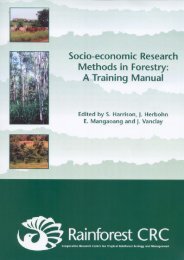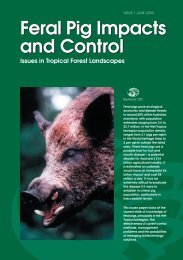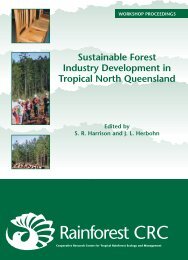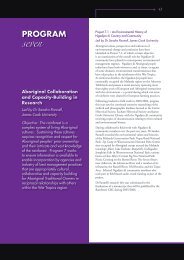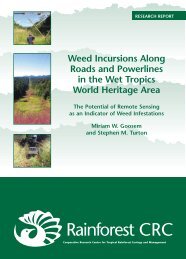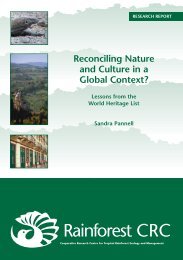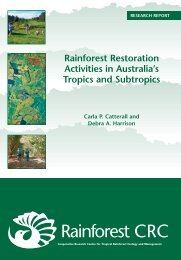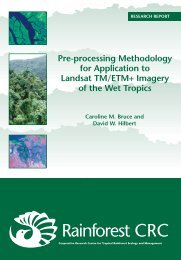S<strong>and</strong>ra PannellAt Suomenl<strong>in</strong>na the erasure of this less picturesque history is materially achieved by therestoration of the fortress complex itself. Ongo<strong>in</strong>g restoration work at the fortress isundertaken to satisfy the authenticity <strong>and</strong> <strong>in</strong>tegrity requirements of the World HeritageConvention. As stated <strong>in</strong> the Convention’s operational guidel<strong>in</strong>es, the “physical fabric” ofproperties nom<strong>in</strong>ated under the ‘cultural’ criteria (i) to (vi), “should be <strong>in</strong> good condition, <strong>and</strong>the impact of deterioration processes controlled” (UNESCO 2005: 22). At Suomenl<strong>in</strong>narestor<strong>in</strong>g the fortifications <strong>in</strong> keep<strong>in</strong>g with their current status as “monument, a culturalcentre, a borough <strong>and</strong> a tourist attraction” (The Estate of Olof af Hällstrom 2004: 49) haseffectively obliterated the material scars of more than three hundred years of warfare. In thisrespect, the Military Fortress of Suomenl<strong>in</strong>na is not alone. As Uzzell <strong>and</strong> Ballantyne po<strong>in</strong>tout, there are “many museums around the world where the sartorial elegance of the soldiery<strong>and</strong> the impressiveness of the <strong>in</strong>struments of war assumes as much if not more significancethat their purpose <strong>and</strong> effect” (1998: 156-157). In these contexts, like Suomenl<strong>in</strong>na, war isreduced to a simple story about the application of military technology <strong>and</strong> <strong>in</strong>dustrialdevelopments to the slaughter of thous<strong>and</strong>s, if not millions, of people. As Uzzell <strong>and</strong>Ballantyne conclude, “as we go back <strong>in</strong> time we seem to be more will<strong>in</strong>g to ignore suffer<strong>in</strong>g<strong>and</strong> treat events <strong>in</strong> a more dis<strong>in</strong>terested way as if they come from a ‘foreign country’” (1998:157). In part, this social ‘forgett<strong>in</strong>g’ of temporally distant <strong>and</strong> shameful events is driven bythe transformation of sites associated with war <strong>and</strong> conflict from memorials <strong>and</strong> places ofremembrance to tourist attractions <strong>and</strong> day-trip dest<strong>in</strong>ations. However, battlefields,massacres sites, <strong>and</strong> the ground zero of mass destruction events, <strong>in</strong> which unspeakableatrocities, horror <strong>and</strong> tragedy are constitutive elements, do not readily provide visitors with an“enterta<strong>in</strong><strong>in</strong>g day out for all the family” (Uzzell <strong>and</strong> Ballantyne 1998: 165). While ‘darktourism’ is identified as a “grow<strong>in</strong>g phenomenon <strong>in</strong> the late twentieth <strong>and</strong> early twenty-firstcenturies” (Lennon <strong>and</strong> Foley 2000: 3), it is apparent that heritage <strong>in</strong>terpretation at these‘fatal attractions’ often presents “a sanitised form of truth which will not upset, offend orchallenge” (Uzzell <strong>and</strong> Ballantyne 1998: 165). This last po<strong>in</strong>t is particularly evident <strong>in</strong> theway that history is <strong>in</strong>terpreted <strong>and</strong> presented at the Military Fortress of Suomenl<strong>in</strong>na.For all the talk of military engagements, there is little sense of the Suomenl<strong>in</strong>na site as acontested cultural doma<strong>in</strong> <strong>in</strong> a presentation that largely celebrates Swedish <strong>and</strong> Russianmilitary history. Indeed, what is <strong>in</strong>terest<strong>in</strong>g about Suomenl<strong>in</strong>na is the way <strong>in</strong> which themilitary achievements of Sweden <strong>and</strong> Russia, <strong>and</strong> their varied historical occupation of theregion, have not been downplayed or rewritten to opportunistically serve the ends ofcontemporary F<strong>in</strong>nish nationalism. Perhaps, this says someth<strong>in</strong>g about the uncerta<strong>in</strong> <strong>and</strong>unf<strong>in</strong>ished nature of F<strong>in</strong>nish nationalism or about the error of assum<strong>in</strong>g the existence of anethnically <strong>in</strong>dependent <strong>and</strong> historically de-contextualised F<strong>in</strong>nish identity. Unlike the WorldHeritage site of Stonehenge, where there is no doubt about the fact that “it belongs to thenation <strong>and</strong> falls under the guardianship of English Heritage” (van der Aa et al. 2005: 18),Suomenl<strong>in</strong>na, while nom<strong>in</strong>ated by the Government of F<strong>in</strong>l<strong>and</strong>, strongly po<strong>in</strong>ts to its ‘sharedheritage’. And while the World Heritage site of the Tower of London monumentalises therock-solid stability of Engl<strong>and</strong>’s constitutional monarchy, Suomenl<strong>in</strong>na po<strong>in</strong>ts to the ebb <strong>and</strong>flow of power <strong>and</strong> illustrates the rise <strong>and</strong> fall of powerful empires <strong>and</strong> long-reign<strong>in</strong>g k<strong>in</strong>gdoms<strong>in</strong> this part of Europe.The identity of Suomenl<strong>in</strong>na as a pivotal focal po<strong>in</strong>t <strong>in</strong> the histories of at least three Europeannations raises some <strong>in</strong>terest<strong>in</strong>g questions about whose heritage it is, who should protect it,<strong>and</strong> if it is a ‘shared heritage’, to what extent does the Convention recognise multilateralnom<strong>in</strong>ations. As to the question of whose heritage it is <strong>and</strong> who should protect it, the WorldHeritage listed site of the Statue of Liberty <strong>and</strong> the associated immigration museum on EllisIsl<strong>and</strong> provide us with some <strong>in</strong>sights <strong>and</strong> possible answers. This site certa<strong>in</strong>ly representsone of the more iconic World Heritage properties to symbolise a multicultural heritage <strong>and</strong>transnational citizenship. As a site associated with the entry of an estimated twelve millionmigrants <strong>in</strong>to the United States of America, the Statue of Liberty site challenges the moresedentary <strong>and</strong> stable read<strong>in</strong>gs of history associated with so many of the cultural heritage50
<strong>Reconcil<strong>in</strong>g</strong> <strong>Nature</strong> <strong>and</strong> <strong>Culture</strong> <strong>in</strong> a <strong>Global</strong> <strong>Context</strong>?Lessons from the World Heritage Listproperties on the List. As Joanne Maddern po<strong>in</strong>ts out, “migration histories necessarilyemphasise geographical connectivity <strong>and</strong> rhizomatic networks that transgress the borders of<strong>in</strong>dividual nation-states” (2005: 25). Symbolic of a period <strong>in</strong> global history, <strong>and</strong> l<strong>in</strong>ked to<strong>in</strong>ternationally diverse memories, the Statue of Liberty is truly a World Heritage site.However, as Maddern reports, there is a constant tension <strong>in</strong> the way that the history of thesite is mobilised <strong>in</strong> support of American nationalism or used to promote a more polysemic<strong>and</strong> universalistic read<strong>in</strong>g. M<strong>in</strong>dful of these tensions <strong>and</strong> the new social history, whichhighlights ‘spatial <strong>in</strong>terconnections’, Maddern advocates, “World Heritage Sites must becomespaces of <strong>in</strong>ter-cultural dialogue […] <strong>and</strong> should aim to promote themselves as transnationalrather than national spaces of citizenship” (2005: 32).Follow<strong>in</strong>g on from Maddern’s comment, <strong>and</strong> return<strong>in</strong>g to the subject of the nom<strong>in</strong>ationprocess, the Convention allows for, <strong>and</strong> has already accommodated, a h<strong>and</strong>ful of multilateralnom<strong>in</strong>ations for transnational properties, <strong>in</strong>clud<strong>in</strong>g the Wadden Sea Conservation Area (v<strong>and</strong>er Aa et al. 2005), the ‘Frontiers of the Roman Empire’ (2005), <strong>and</strong> ‘The Belfries of Belgium<strong>and</strong> France’ (2005). As the 2005 list<strong>in</strong>g dates for these properties allude to, thesenom<strong>in</strong>ations reflect a recent trend towards a more thematic <strong>and</strong> <strong>in</strong>tegrated approach tonatural <strong>and</strong> cultural World Heritage. As Fowler suggests, the concept of ‘cultural l<strong>and</strong>scape’,acknowledged <strong>in</strong> the operational guidel<strong>in</strong>es for the World Heritage Convention s<strong>in</strong>ce 1992,allows for the expression of theme-based cultural heritage, rather than just the monumentbasedexamples that dom<strong>in</strong>ate the World Heritage List (2003: 57). In this respect, l<strong>in</strong>k<strong>in</strong>gSuomenl<strong>in</strong>na to the already listed (1990) Historic Centre of Sa<strong>in</strong>t Petersburg, the WorldHeritage Naval Port of Karlskrona <strong>in</strong> Sweden (listed <strong>in</strong> 1998), <strong>and</strong> the Historic Centres ofStralsund <strong>and</strong> Wismar <strong>in</strong> Germany (listed <strong>in</strong> 2002), as part of a broader geo-political ‘militarycultural l<strong>and</strong>scape’ (see Fowler 2003: 58), would make far greater thematic sense. Judg<strong>in</strong>gby the properties <strong>in</strong>scribed on the World Heritage List to date, it appears that ‘historiccentres’ have traditionally occupied some of the broader thematic spaces suggested byFowler.THE HISTORIC CENTRE OF MACAU 53The World Heritage List features a number of sites <strong>in</strong>scribed as ‘historic centres’, ‘districts’,‘zones’, <strong>and</strong> ‘quarters’. These <strong>in</strong>clude the historic centres of Quebec (1985), Mexico City(1987), Brugge (2000), Vienna (2001) <strong>and</strong> Valparaíso (2003). Of the 628 cultural propertiescurrently <strong>in</strong>scribed on the World Heritage List, 56 of these are identified as some form of‘historic centre’. With seven listed historic centres each, Italy <strong>and</strong> Mexico have the highestnumber of such sites out of all the member parties to the Convention. Distributed throughoutthe ‘old’ <strong>and</strong> ‘new world’, as the term suggests, these centres largely comprise all thatrema<strong>in</strong>s of ancient, medieval, Moorish, renaissance, or colonial settlements, now enclosedby a more recent <strong>and</strong> modern built environment. While perhaps not as comprehensive asthe many listed ‘historic villages, towns <strong>and</strong> cities’, historic centres have greater thematic<strong>in</strong>tegrity than those sites identified as ‘historic monuments’ with<strong>in</strong> exist<strong>in</strong>g built enclaves.Listed <strong>in</strong> 2005, Macau is one of the latest additions <strong>in</strong> the acknowledgement of historiccentres as World Heritage sites. This tradition dates back to 1980, with the list<strong>in</strong>g of theHistoric Centre of Rome. Macau is not only the most recent historic centre listed, but it alsorepresents the first nom<strong>in</strong>ation of this k<strong>in</strong>d from the People’s Republic of Ch<strong>in</strong>a.Situated on the south-east coast of Ch<strong>in</strong>a, sixty kilometres from Hong Kong, for many of thefifteen million visitors to the area, the Macau Pen<strong>in</strong>sula is a brief break <strong>and</strong> ferry ride away53 As if to emphasise its colonial past, the World Heritage Centre has reta<strong>in</strong>ed the orig<strong>in</strong>al spell<strong>in</strong>g ofthe name of this former Portuguese outpost “Macao”, rather than adopt the name used by thepresent-day Macau Government.51




